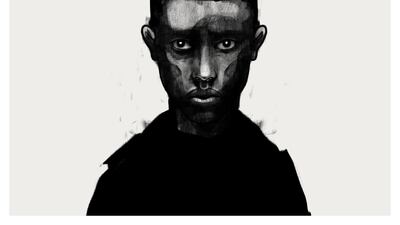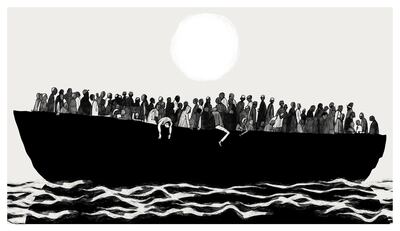It was no ordinary coach journey that delivered Ammar Raad from Paris to London in 2016.
After nine hours hidden in a suitcase, the Syrian refugee finally emerged from the coach’s hold so drenched in sweat that the dye from his clothes had run, staining his skin.
Not that Raad minded. He was one of the lucky few. After more than 300 failed attempts, Raad, originally from al-Qusayr, a town of around 100,000 inhabitants just outside Homs, had finally reached the United Kingdom, and with it his twin brother, Emad, who had also succeeded in making the crossing.
Like his brother, Ammar was granted asylum in the UK and now lives in London, where he is enrolled on an undergraduate course in International Relations at London Metropolitan University.
Journeys Drawn
The 31-year-old's story also features in an exhibition, Journeys Drawn: Illustration from the Refugee Crisis at the House of Illustration in London's King's Cross, the first UK show to explore the refugee crisis through the work of illustrators.

The show features 40 drawings from a dozen artists, such as graphic novelist Kate Evans, whose Threads: From the Refugee Crisis documents life in the Jungle, the impromptu encampment near the French port town of Calais, and the Iranian artist Majid Adin, an asylum seeker from Mashad, in north-east Iran, who made his way into the UK from Calais locked in a fridge in the back of a van.
Adin hit headlines earlier this year when he won a competition to make an animation for the Elton John ballad, Rocket Man, which tells the story of somebody reluctantly jetting into space and having to leave his family behind.
Illustrating complex human stories
For the show's curator, Katie Nairne, Journeys Drawn not only stands as a testament to a global humanitarian crisis, but to the power of illustration to tackle complex human stories in ways that are uniquely engaging and humane. Illustrators have the unique opportunity to act as visual journalists, spending extended periods of time in situations where photography is either banned or too intrusive.
“There has always been political debate around the subjects of asylum and immigration, but it seems it is often discussed in a way that can obscure the experiences of refugees themselves,” she explains. “The idea of the exhibition was to redress this balance by bringing together illustration that gives a glimpse of the individual journeys refugees have experienced, whether through reportage, comics or animation.”
It was towards the end of Ammar Raad’s 11-month stint in the Jungle that his likeness was captured by the award-winning German reportage illustrator Olivier Kugler.
Recognised internationally for his work for The Guardian, Kugler has been documenting the plight of Syrian refugees since 2013 when, thanks to a commission from the international humanitarian organisation Medecins Sans Frontieres (MSF), he visited the Domiz refugee camp in Iraqi Kurdistan.
Two years later, Kugler visited the Greek island of Kos, again with MSF and then, in spring 2016, he visited the Jungle to complete a body of work that was published earlier this year in Escaping Wars and Waves: Encounters with Syrian Refugees, which charts the stories of Syrians fleeing war in search of a safe haven in Europe.

Journalism meets illustration
Raad’s portrait appears in both the exhibition and the book, which is as much an act of journalism as illustration, although Kugler insists that the drawing comes first. “I am an illustrator, the journalistic aspect is something that comes later. First of all I am looking for motifs that I want to draw,” the artist explains from his studio in London. “I want to get different stories about people from different backgrounds, different ages and different sexes.”
In comparison to his experiences in Iraq and Greece, Kugler admits that finding Syrians in France who were willing to tell their stories was a challenge. "I found it difficult to find people who wanted to talk to me," he says. "When I was in Iraqi Kurdistan in Kos, people were happier and interested to talk but in Calais it was different.
“People were basically stuck there. They were frustrated and there were lots of journalists, camera crews and photographers running around. There were even refugee tourists in the camp who had come to take photos, so I think people thought that they wouldn’t get anything out of talking to me.”
Although Kugler was in the Jungle working in his own time, a worker from MSF helped the artist by introducing him to Raad and two other men who were sharing the same makeshift shelter. "He and his friends had been trying to scale the fence every night for six months and they had always been caught by the police," Kugler recalls. "They were really frustrated when I met them."
What followed was a process that Kugler has perfected over the years in refugee camps, soup kitchens, war zones and among the homeless. Rather than drawing in the field, he looks for visually arresting scenes, conducts interviews and records conversations with willing subjects, while taking copious photographs that he uses as the basis for his drawings. "You have to soak up the atmosphere and get as many photos as you can and conduct as many interviews to get a broad collection of stories and very rich reference material," he tells me.
“I sometimes compare myself to a locust.”
'A lot of people didn't want to get recognised'
Kugler starts by telling people he is an illustrator from Germany, that he is working on a book about the refugee crisis and that the drawings might be published in a magazine or a newspaper. “Some people say no. A lot of people didn’t want to get recognised because they might say something political against the regime or any of the other parties involved in the conflict,” Kugler admits. “Another reason [people decline] could be that they just don’t like the idea of being interviewed or photographed by a stranger.”
Despite having to overcome what he describes as an innate shyness when it comes to approaching people, Kugler believes that being an illustrator affords him a unique level of access to his subjects. “It helps make access easier to people in some cases, in comparison to classical photography,” he says.
"Many people don't want to be photographed, but when I tell them that I am going to create a drawing of them and that the reference photos won't be published anywhere, they are much more open to idea of telling me their stories.
“I guess with illustration it’s also a much more individual way of expressing yourself, so if people see the work and they like your style, they get it.”
After seeing the public's reaction to his drawings at exhibitions, Kugler also believes that illustration can have an impact on audiences who are jaded by more traditional forms of news coverage. "There was an elderly couple who came twice to the exhibition," Kugler says, remembering a show in Switzerland. "They spent a long time looking at the work, reading the text, and they told me that they have been around for a long time and seen footage on TV and in newspapers about people living in refugee camps.
“They said that if they see it now, it doesn’t move them anymore because they feel saturated with these kinds of images that combine drawing and text, they got drawn into the people’s stories and they wanted to know more.”
Journeys Drawn: Illustration from the Refugee Crisis runs at the House of Illustration in London until March 24, 2019.
______________________
Read more:
Belgium's Africa museum: a fitting tribute or a testament to colonialism?
Fourth Kochi-Muziris biennale looks to politics and friendship
Inside Banksy's The Walled Off Hotel in Bethlehem
The Palestinian artists giving new life to the streets of Beit Sahour
______________________


